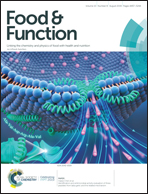Association of dietary fiber intake with hyperuricemia in U.S. adults
Abstract
Current evidence on the relationship between dietary fiber intake and risk of hyperuricemia is limited. The aim of the present study was to examine their associations in the U.S. general adult population. Data from the National Health and Nutrition Examination Survey (NHANES) 2009 to 2014 were used. Dietary fiber intake was extracted through two 24 h dietary recall interviews. Hyperuricemia was defined by cut-off values of 7.0 mg dL−1 for men and 6.0 mg dL−1 for women. Multivariable logistic regression models and restricted cubic spline models were applied to explore the associations between dietary intakes of total, cereal, fruit and vegetable fiber and the risk of hyperuricemia. A total of 12 869 participants aged 20 years or older were included in the present study. The multivariable odds ratio (OR) and 95% confidence interval (CI) of hyperuricemia for the highest vs. lowest quartile intake of total fiber were 0.58 (0.46–0.74), 0.61 (0.52–0.74) for cereal fiber, 0.94 (0.76–1.16) for fruit fiber and 0.95 (0.76–1.18) for vegetable fiber. The inverse associations between dietary intakes of total fiber and cereal fiber and the risk of hyperuricemia were observed in men. In stratified analysis by age (<45 years, ≥45 years), the inverse association between total fiber intake and the risk of hyperuricemia was consistent, while cereal fiber intake was only inversely associated with hyperuricemia among participants <45 years old. Dose–response analyses showed that the risk of hyperuricemia was associated with dietary intake of total fiber in a nonlinear manner, whereas the relationship was linear for cereal fiber intake. In conclusion, dietary intakes of total fiber and cereal fiber were inversely associated with the risk of hyperuricemia in the U.S. adult population.



 Please wait while we load your content...
Please wait while we load your content...